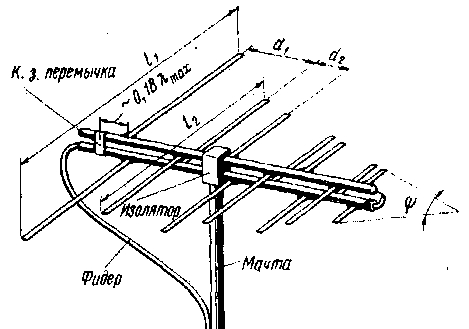
|
|
ENCYCLOPEDIA OF RADIO ELECTRONICS AND ELECTRICAL ENGINEERING log-periodic antenna. Encyclopedia of radio electronics and electrical engineering
Encyclopedia of radio electronics and electrical engineering / HF antennas A log-periodic antenna is a broadband directional antenna operating in a tenfold or wider wavelength range. In terms of gain, the antenna is equivalent to a three-four-element "wave channel" antenna. It can be used to receive signals from multi-program telecenters with any combination of VHF and VHF channels (channels 1-41). One of the simple antenna options is shown in Fig.1. The antenna consists of a number of parallel vibrators connected to a two-wire line with serial polarity reversal of the vibrators feed points. The lengths of the vibrators and the distances between them decrease exponentially towards the feeder connection points. Behind the longest vibrator, a short-circuit jumper is installed, which improves the matching of the antenna with the feeder and provides balancing.
The cable is passed inside one of the tubes of the two-wire line and soldered from the side of the shortest vibrator, as shown in Fig.1. The characteristics of the antenna depend on the denominator of a geometric progression m, which characterizes the rate of decrease in the lengths of the vibrators and the distances between them, and the angle φ at the top of the triangle in which the vibrators are inscribed. The closer m to unity and the smaller f, the greater the gain of the antenna, but at the same time its dimensions and weight increase. In practice, they usually take m = 0,8-0,9 and f = 30-40 °, which makes it possible to obtain a sufficiently high gain with relatively small dimensions and weight. With selected t and f, the dimensions of the antenna can be determined graphically based on Lmax and Lmin - the maximum and minimum wavelengths of the operating frequency band. First, you should determine the length l1 of the first (largest) vibrator, which should be 0,55 Lmax, then draw an isosceles triangle with a base equal to the length of the first vibrator on a reduced scale (for example, 1 : 20 or 1 : 50), and the selected angle φ at the top. In the future, all constructions and calculations should be performed taking into account the same scale. The second vibrator is placed at a distance d1 = (0,15-0,18) Lmax. Its length l2 is equal to the length of a straight line segment drawn parallel to the base at the appropriate distance.
The third vibrator is placed at a distance d2=d1t from the second, and its length l3 is equal to the length of the straight line segment drawn at this distance from the second vibrator. Similarly, the length of the fourth vibrator is determined, located at a distance d3=d2t from the third one, etc. The last one is the vibrator, the length of which will be less than 0,45 Lmin. Figure 2, a shows the dimensions of the antenna for channels 1-12, in figure 2, b - for channels 1-5, in figure 2, c - for channels 6-12. Using the described technique, it is possible to calculate the antenna for channels 1-41, as well as for another required frequency band. The antenna gain is 6-7 dB, the level of side lobes is from -12 to -14 dB, the KBV is more than 0,5. The diameter of the tubes of the two-wire line is 22 mm, the distance between the centers is 32 mm, the diameter of the vibrators is 12-14 mm. Drop cable - with a wave impedance of 75 ohms. Handbook of radio amateur-designer Addendum from Nikolai Bolshakov Personally, I have collected several similar antennas for the decimeter range of television. Pieces of copper wire with a diameter of 0,8 - 1,5 mm and two plates of one-sided foil fiberglass were used as the material. Wire vibrators are soldered to the plates. The design is very simple and easily repeatable. Antenna dimensions for the 400-850 MHz range are shown in the figure below. Solder wire vibrators on plates 25x220 mm in size (both parts are exactly the same), the lower half rotates 180 degrees relative to the axis. Both plates are connected through bushings (5-10 mm) with screws through the holes at the ends of the plates. The screws must be insulated from the foil. The cable is located between the plates.
Antenna dimensions for the 850-950 MHz band (radio telephones) Table 1
Theoretically parameters:
Publication: N. Bolshakov, rf.atnn.ru
Machine for thinning flowers in gardens
02.05.2024 Advanced Infrared Microscope
02.05.2024 Air trap for insects
01.05.2024
▪ A new kind of computer sport ▪ Sony and Samsung continue the LCD race
▪ section of the site Your stories. Article selection ▪ Article Liberty, Equality and Fraternity. Popular expression ▪ article How many people in the world do not have any citizenship or nationality? Detailed answer ▪ article Soya cultural. Legends, cultivation, methods of application ▪ article Knife can be at the top. physical experiment
Home page | Library | Articles | Website map | Site Reviews www.diagram.com.ua |






 Arabic
Arabic Bengali
Bengali Chinese
Chinese English
English French
French German
German Hebrew
Hebrew Hindi
Hindi Italian
Italian Japanese
Japanese Korean
Korean Malay
Malay Polish
Polish Portuguese
Portuguese Spanish
Spanish Turkish
Turkish Ukrainian
Ukrainian Vietnamese
Vietnamese



 Leave your comment on this article:
Leave your comment on this article: